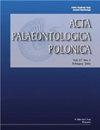Petrosal and cranial vascular system of the early Eocene palaeoryctid Eoryctes melanus from northwestern Wyoming, USA
IF 1.9
3区 地球科学
Q2 PALEONTOLOGY
引用次数: 3
Abstract
The petrosal and neighboring bones of the early Eocene palaeoryctid mammal Eoryctes melanus are described in tympanic and endocranial views based on CT scan data of the holotype. A second cranium of E. melanus has fragments of an osseous bulla, which have been interpreted as possibly formed by an independent entotympanic. The CT scans of the holotype reveal that the medial bullar wall is formed by an expanded rostral tympanic process of the petrosal, but the element(s) in the bullar floor remain unknown. The CT scans also allow for a comprehensive reconstruction of the cranial arterial and venous system. The arterial pattern differs from that in early eutherians by the absence of the arteria diploëtica magna and the bifurcation of the end branches of the stapedial artery dorsal to the tympanic roof. The venous pattern includes a large frontal diploic vein arising from the dorsal sagittal sinus on the midline and running through the frontal bone in a canal. Comparisons are made with other palaeoryctids, various Paleogene mammals (pantolestids, leptictids, apternodontids, apatemyids, and cimolestids) and the extant lipotyphlan Solenodon paradoxus. For the last taxon, the structure of the piriform fenestra and associated arteries is detailed. Cranial features support the monophyly of palaeoryctids and suggest possible lipotyphlan affinities.美国怀俄明西北部早始新世古旋回动物黑纹旋回动物的岩质和颅骨血管系统
基于CT扫描数据,对早始新世古周期哺乳动物黑斑古周期动物(Eoryctes melanus)的岩骨及其邻近骨骼进行了鼓室和颅腔图像的描述。另一种黑鳗的头盖骨有骨球的碎片,被解释为可能是由独立的内鼓室形成的。CT全型扫描显示,内侧壁是由扩大的岩骨吻侧鼓室突形成的,但仍不清楚黄底的组成部分。CT扫描也允许全面重建颅动脉和静脉系统。动脉形态与早期真兽不同,无diploëtica大动脉,镫骨动脉末端分支在鼓室顶背侧分叉。静脉形态包括一条大的额静脉,起源于中线上的背矢状窦,在椎管中穿过额骨。并与其他古兽类、各种古近系哺乳动物(甲兽类、瘦兽类、翼齿兽类、甲兽类和卷兽类)和现存的脂兽(lipotyphlan Solenodon paradoxus)进行了比较。对于最后一个分类群,梨状窗和相关动脉的结构是详细的。颅骨特征支持古周期动物的单系性,并提示可能的脂类亲缘关系。
本文章由计算机程序翻译,如有差异,请以英文原文为准。
求助全文
约1分钟内获得全文
求助全文
来源期刊

Acta Palaeontologica Polonica
地学-古生物学
CiteScore
2.80
自引率
5.60%
发文量
36
审稿时长
12.5 months
期刊介绍:
Acta Palaeontologica Polonica is an international quarterly journal publishing papers of general interest from all areas of paleontology. Since its founding by Roman Kozłowski in 1956, various currents of modern paleontology have been represented in the contents of the journal, especially those rooted in biologically oriented paleontology, an area he helped establish.
In-depth studies of all kinds of fossils, of the mode of life of ancient organisms and structure of their skeletons are welcome, as those offering stratigraphically ordered evidence of evolution. Work on vertebrates and applications of fossil evidence to developmental studies, both ontogeny and astogeny of clonal organisms, have a long tradition in our journal. Evolution of the biosphere and its ecosystems, as inferred from geochemical evidence, has also been the focus of studies published in the journal.
 求助内容:
求助内容: 应助结果提醒方式:
应助结果提醒方式:


